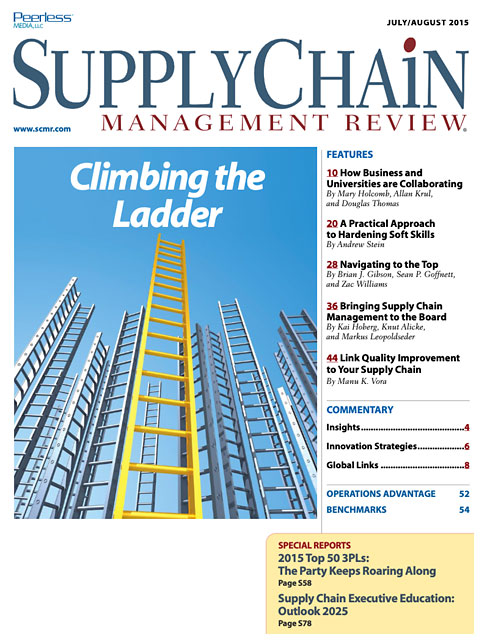Sorry, but your login has failed. Please recheck your login information and resubmit. If your subscription has expired, renew here.
July/August 2015
When it comes to career development, supply chain managers have to execute a bit of jiu jitsu. They’re charged with nding and developing the next generation of talent while simultaneously advancing their own careers in a eld that is often overlooked by senior management. The biggest challenge of all is getting their agenda in front of the Board at a time when supply chain operations are more critical than ever to an organization’s success, but still largely invisible compared to sales, marketing, and product development. Remember: It’s your career—and your supply chain. We hope this month’s issue will help you make the most of both. Browse this issue archive.Need Help? Contact customer service 847-559-7581 More options
In recent years, manufacturers have been outsourcing increasingly larger pieces of their operations. Even historically sacred cows such as engineering, R&D, and product development are now commonly outsourced, as companies search for flexibility and liquidity at a time of unprecedented global competition and high economic uncertainty.
Original equipment manufacturers (OEM) may be happy to push cost and complexity outside of their company walls—and Tier 1 suppliers may be just as happy to pick up the pieces and build their own vertically integrated operations in a bid to improve their competitive positioning and gain additional margin—but there is a downside. OEMs are relinquishing control over huge chunks of their manufacturing cost structure.
To keep their competitive edge, OEMs need to get back into the driver’s seat and adopt a true end-to-end (E2E) perspective of their value chain—one that goes from their raw material suppliers to their end consumers and, in today’s “circular economy,” even to their recyclers. It’s not so much about collaborating more effectively across internal functional lines or even beyond the company walls, but rather about increasing the level of synchronization, transparency, and trust among all the players in the value chain. What will distinguish the winners from the pack is that the leaders will act as “orchestrators” of their E2E value chain.
 |
This complete article is available to subscribers
only. Click on Log In Now at the top of this article for full access. Or, Start your PLUS+ subscription for instant access. |
SC
MR
Sorry, but your login has failed. Please recheck your login information and resubmit. If your subscription has expired, renew here.
July/August 2015
When it comes to career development, supply chain managers have to execute a bit of jiu jitsu. They’re charged with nding and developing the next generation of talent while simultaneously advancing their own careers… Browse this issue archive. Access your online digital edition. Download a PDF file of the July/August 2015 issue.
 |
Download Article PDF |
In recent years, manufacturers have been outsourcing increasingly larger pieces of their operations. Even historically sacred cows such as engineering, R&D, and product development are now commonly outsourced, as companies search for flexibility and liquidity at a time of unprecedented global competition and high economic uncertainty.
Original equipment manufacturers (OEM) may be happy to push cost and complexity outside of their company walls—and Tier 1 suppliers may be just as happy to pick up the pieces and build their own vertically integrated operations in a bid to improve their competitive positioning and gain additional margin—but there is a downside. OEMs are relinquishing control over huge chunks of their manufacturing cost structure.
To keep their competitive edge, OEMs need to get back into the driver's seat and adopt a true end-to-end (E2E) perspective of their value chain—one that goes from their raw material suppliers to their end consumers and, in today's “circular economy,” even to their recyclers. It's not so much about collaborating more effectively across internal functional lines or even beyond the company walls, but rather about increasing the level of synchronization, transparency, and trust among all the players in the value chain. What will distinguish the winners from the pack is that the leaders will act as “orchestrators” of their E2E value chain.
 |
SUBSCRIBERS: Click here to download PDF of the full article. |
SC
MR

Latest Supply Chain News
- Retail sales see gains in October, reports Commerce and NRF
- Balancing green and speed: Home delivery insights from the pandemic era
- AdventHealth named top healthcare supply chain by Gartner
- Geopolitical readiness in supply chains: Strategic challenges for leaders
- Unlocking retention: The role employee engagement plays
- More News
Latest Podcast

 Explore
Explore
Topics
Latest Supply Chain News
- Retail sales see gains in October, reports Commerce and NRF
- Balancing green and speed: Home delivery insights from the pandemic era
- AdventHealth named top healthcare supply chain by Gartner
- Geopolitical readiness in supply chains: Strategic challenges for leaders
- Unlocking retention: The role employee engagement plays
- Can supply chain managers embrace an entrepreneurial mindset?
- More latest news
Latest Resources

Subscribe

Supply Chain Management Review delivers the best industry content.

Editors’ Picks





